Ear Piercing: Types,
Styles, and Tips for Choosing the Perfect Piercing
Ear piercing is not just a classic accessory but also an art form, allowing you to express yourself and enhance your style.
There are many types of piercings that allow for unique combinations and styles. Let's look at the main types of ear piercing, their features, and the best jewelry styles for each.
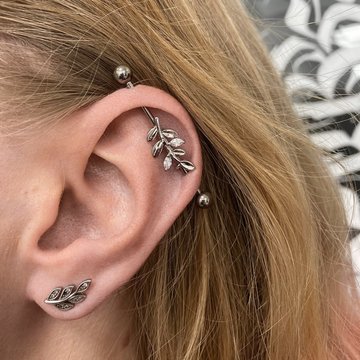
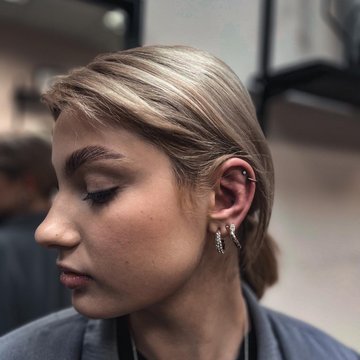
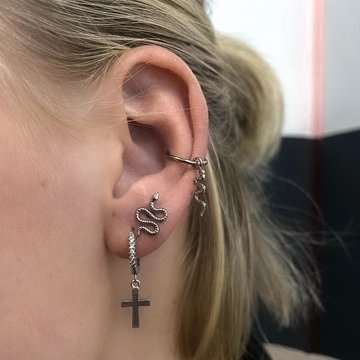
A Little History: From
Ancient Traditions to Modern Fashion
Ear adornment has deep roots across different cultures.
In ancient times, piercing served not only as decoration but also as a symbol of status, a talisman, or a sign of maturity. Even today, traditions of ear piercing remain in African, Indian, and Southeast Asian tribes, where unique earrings are used to show social status or even family role.
Today, ear piercings are popular worldwide and accessible to everyone—from classic studs to extravagant combinations covering the entire ear. This form of body art offers a personalized approach to choosing a style, from minimalist to avant-garde.


Types of Ear Piercings
Ear piercings can be simple or layered.
Let’s review popular types and their specific features.
- Classic Earlobe
- The most common and versatile piercing, suitable for all ages and styles. Usually, it’s placed in the lower part of the earlobe, making it ideal for various earring types—from small studs to large hoops.
- High Lobe
- This piercing is positioned higher than the classic lobe piercing, closer to the cartilage. Suitable jewelry includes studs or small hoops, which can be paired with a classic earlobe piercing for a layered effect.
- Helix
- A piercing in the outer cartilage at the top of the ear. The helix allows for rings, horseshoes, or delicate stud earrings with stones. For a more impactful look, multiple helix piercings can be added along the outer ear line to create a trendy cascading effect.
- Forward Helix
- A piercing in the front part of the ear cartilage, closer to the face. A forward helix looks especially stylish with three or more piercings that can be decorated with stud earrings. This option is great for those who want to emphasize the ear without drawing too much attention to its center.
- Tragus
- A piercing in the small projection in front of the ear canal. This popular, stylish piercing suits small studs or hoops and has a neat, interesting appearance, especially when combined with other ear piercings.
- Anti-Tragus
- A piercing in the lower cartilage opposite the tragus. The anti-tragus stands out and works well with small jewelry like mini hoops or studs. This piercing requires a longer healing period but adds a unique accent to the look.
- Daith
- A piercing in the cartilage of the inner ear fold. The daith is popular for its unusual location and is thought to have acupuncture benefits, with some saying it can help relieve migraines. For this piercing, small hoops that fit snugly to the inner ear are a popular choice.
- Rook
- Located in the inner cartilage of the upper ear, rook piercings are chosen for their unique look as they sit in the inner ear area, highlighting the ear contour.
- Industrial
- An industrial piercing includes two piercings in the upper and lower ear cartilage, connected by one long piece of jewelry, usually a barbell. This piercing type requires experience and healing time but has a bold look, adding an edgy touch to any style.
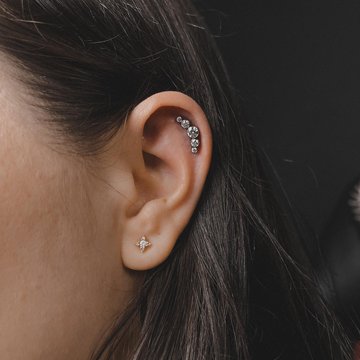
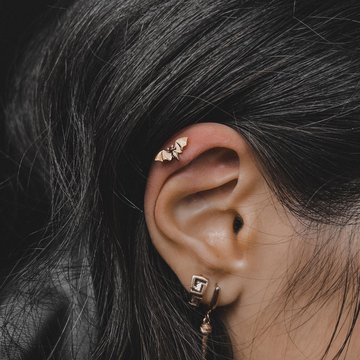
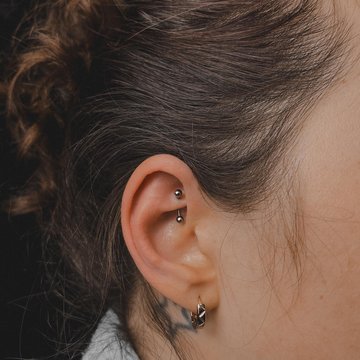
How to Choose
an Ear Piercing Style
When choosing an ear piercing style, it’s essential to consider several factors to ensure it complements your appearance and lifestyle.
First, take your ear shape and structure into account. Not all types of piercings are suitable for everyone; for instance, industrial or rook piercings might not work if your ear doesn’t have sufficiently even and wide cartilage areas.
It’s also worth considering the combination of different piercings. Using multiple piercing types allows you to create a unique look that reflects your personality. For instance, pairing a helix with a forward helix and several earlobe piercings can make for a stylish, layered look.
Another key factor is jewelry choice. For minimalist, understated styles, small studs, rings, or plain pins are ideal. If you prefer a bolder style, you might choose jewelry with stones, pendants, or chains for added color and flair.
Don’t forget to think about whether piercings are allowed at your workplace. If your job requires a formal dress code, you might prefer subtle, discreet jewelry or choose piercings that are easy to hide behind your hair.
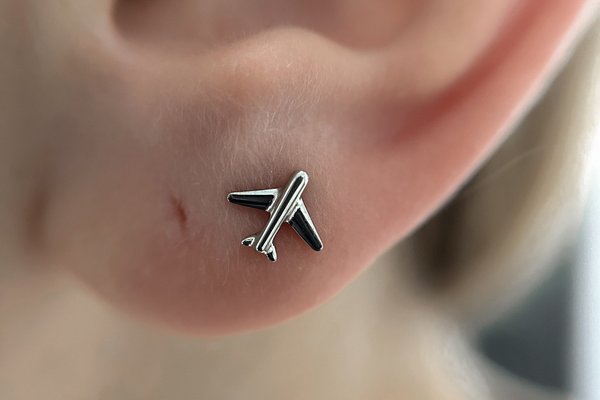
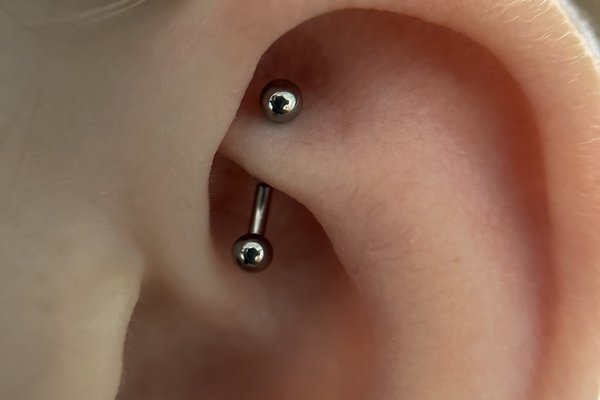
How to Care for an Ear Piercing
Piercing care is a crucial step that determines how quickly and comfortably the healing process goes.
Following these recommendations can help avoid complications:
- Cleaning: Clean the piercing daily with a special saline solution or the solution recommended by your piercer until healing is complete.
- Avoid injury: Try not to touch the jewelry unnecessarily and avoid catching it on clothing or hair.
- Watch for signs of inflammation: If you notice redness, swelling, or pain, see a professional to avoid infection.
- Don’t change jewelry prematurely: The minimum time to change jewelry varies from a few weeks to a few months, depending on the type of piercing.
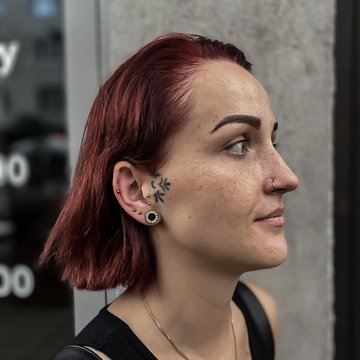
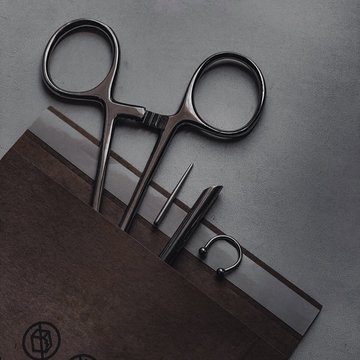

Popular Jewelry
for Ear Piercings
Modern ear piercing jewelry offers a wide variety:
- Studs and pins – perfect for earlobe and forward helix piercings.
- Rings and horseshoes – look great in helix, tragus, and daith piercings.
- Barbells – ideal for industrial and other layered combinations.
- Miniature chains and pendants – add elegance to the look and emphasize individuality.
Conclusion
Ear piercing is a fantastic way to add expression to your look. With the variety of piercing types and jewelry available, you can create a unique design that matches your style and taste. If you want a high-quality and safe piercing, visit the professionals at VEAN TATTOO Studio. Experienced piercers will help you choose the ideal piercing type and jewelry, as well as ensure proper aftercare to keep your piercing looking great for years.
Ear piercing not only offers the chance to wear jewelry but also emphasizes individuality, keeping your style confident and unique.

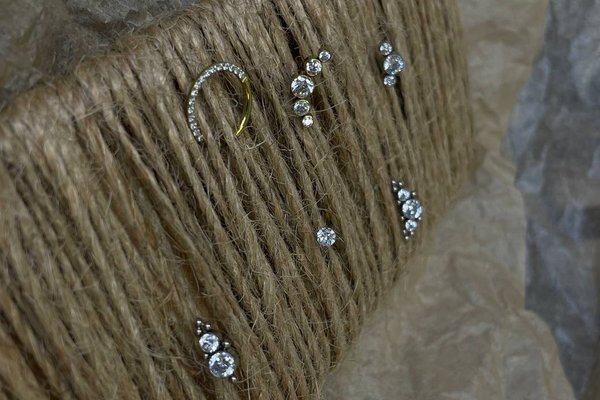


 Create a sketch in the VEAN TATTOO AI generator
Create a sketch in the VEAN TATTOO AI generator




